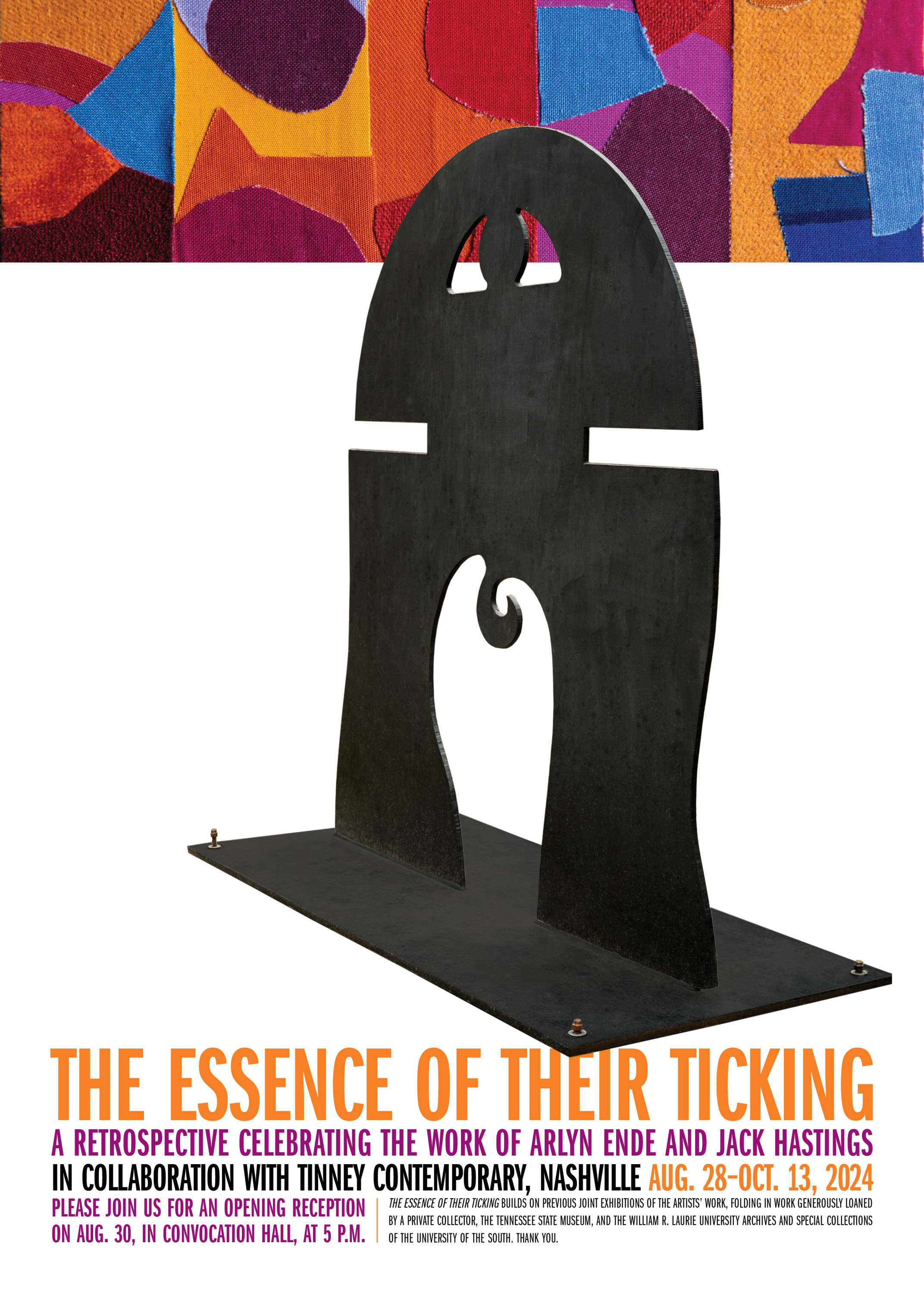The University Art Gallery is delighted to present The Essence of Their Ticking, a retrospective celebrating the work of Arlyn Ende (1932-2022) and Jack Hastings (1925-2013), in collaboration with Tinney Contemporary, Nashville, from August 28 through October 13, 2024.
Arlyn Ende and Jack Hastings were remarkable people and artists, and beloved community members. Their lives and work together spanned decades and places, from their meeting in New Orleans in the 1950s, to New York and Boston, to Rhode Island and Arizona. They made Tennessee their home in 1972, first on a farm in Bradyville, and then, after 1994, in Sewanee at their homestead Deepwoods.
In some ways, their work could not be more distinct. Ende worked extensively with textiles, while Hastings sculpted in concrete and metal. Ende explored liminalities and ephemeral states, while Hastings embodied archetypes. Both were inventive and adaptable, expansive and generous. They thought, dreamed, and worked at a community-wide—and sometimes even universal—scale.
Embracing different media, and constantly experimenting, both were ingenious—designing looms to accommodate the scale of her work in Ende’s case, working out how to transport and install so many tons of concrete or metal in Hastings’. Both thought very carefully about how their work would be embedded in a place, about how it would change over time, and about how it could be responsive.
Arlyn Ende studied pre-med and fine art at Louisiana State University, as well as design at the School of the Art Institute of Chicago and drawing at the Tulane School of Architecture. Throughout her career she worked with textiles—designing dresses for her clothing line FogEater (1966-1972), creating large scale “tapetas” to warm and humanize commercial and institutional spaces (1979-2010), and hooking inventive, playful rugs. In the early 2000s she moved towards printmaking and collage, with specific attention to ecologically friendly methods. For many years Ende’s competition-winning wall textiles (commissioned 1980) offered wayfinding and comfort for eleven floors of Vanderbilt Medical Center in Nashville. From the earliest days of her career in New Orleans and New York, Ende also used her expertise and know-how to foster the work of others. Here in Tennessee she was first president of the Cannon Association of Craft Artists, and was instrumental in launching the Arts Center of Cannon County, including acting as their first Program Director from 1992 to 1994. At the University of the South, she was Director of the University Art Gallery from December 2000 until mid-2007.
Jack Hastings trained at Louisiana State University, and at the Escuela de Pintura, Escultura y Grabado in Mexico City. Inspired by Conrad Albrizio and Diego Rivera, he began as a muralist, then cast bronze, carved cement, cold-formed steel, and shaped and painted sheet metal. Throughout his practice he integrated his artwork into architectural settings, into the landscape, and into the communal experience of a place. For many years his monumental steel mobiles Homage to Calder (1986) and Dancing on Air (1999) graced and enlivened TVA Headquarters in Chattanooga and the Nashville International Airport. Outdoor installations of Hastings' work in concrete can be found nearby the exhibition in the University Art Gallery—in the Charles Gooding Memorial Garden at Saint Andrew’s-Sewanee School (1998) and the Environmental Garden at the I-75 Welcome Center in Chattanooga (1982). Hastings’ painted steel sculptures (Standing Ovation (1992) and Logos (2000)) act as landmarks for The Arts Center of Cannon County, and at Stirling's Coffee House on the campus of the University of the South.
This exhibition builds on Tinney Contemporary’s prior exhibitions of Arlyn Ende and Jack Hastings’ work, folding in work generously loaned by the Tennessee State Museum, the William R. Laurie University Archives and Special Collections of the University of the South, and a private collector.
The University Art Gallery is open from 10 a.m. to 5 p.m. Tuesdays through Fridays, and noon until 4 p.m. on Saturdays and Sundays.


